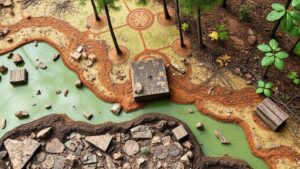Tracing Historical Water Canal Projects for Forgotten Engineering Tools
Tracing Historical Water Canal Projects for Forgotten Engineering Tools
The engineering feats of the past often provide insights into both the technological advances of their time and the tools that have been lost to history. Water canals, as a means of transportation and irrigation, are one such example where various engineering tools played a crucial role. This article chronicles significant water canal projects through history, highlighting the engineering tools employed, their functions, and the impact of these projects on civilization.
Historical Context of Water Canals
Water canals have been integral to agricultural development and urbanization since ancient times. construction of canals dates back to prehistoric societies, with significant advancements made in various cultures, including the Sumerians, Egyptians, and later, the Romans.
One of the earliest known canals, the Shatt al-Arab, emerged around 4000 BCE in modern-day Iraq. This canal facilitated trade and irrigation, underscoring the importance of waterways in Sumerian society.
Key Engineering Tools and Techniques
Throughout the development of canal systems, specific tools and techniques were essential to their construction and maintenance. The following tools were instrumental:
- Archimedean Screw: Developed by Archimedes in the 3rd century BCE, this device was crucial for lifting water, particularly in irrigation systems.
- Canal Dredgers: Used extensively in the 18th and 19th centuries for excavating and maintaining canal depth, these tools facilitated navigation and water flow.
- Levees and Dikes: These structures were integral to controlling water levels and preventing flooding, highlighting advanced understanding of hydrology.
Notable Canal Projects
Several monumental canal projects throughout history demonstrate the innovative engineering that has shaped societies. Key examples include:
- The Suez Canal: Completed in 1869, the Suez Canal revolutionized global trade routes by connecting the Mediterranean and Red Seas. The tools used included steam shovels and dredgers which expedited excavation.
- The Panama Canal: Finished in 1914, it was a marvel of engineering that required complex locks and extensive earthmoving tools such as steam shovels and dynamite.
- The Erie Canal: Opened in 1825 in New York, this canal utilized techniques such as lock systems to navigate elevation changes, along with tools like horse-drawn dredges.
Impact on Society and Economy
Canals have historically driven economic growth by providing efficient transport options for goods and services. For example, the Erie Canal massively reduced the cost of shipping and encouraged settlement in the northeastern United States, leading to a population increase of 2 million people between 1825 and 1850.
Also, canals have facilitated irrigation, which has transformed agricultural practices. In Egypt, canals have historically supported the cultivation of crops along the Nile, sustaining the population for millennia.
Challenges and Forgotten Tools
Despite their immense utility, many canal-related tools have fallen out of use and are now deemed forgotten. For example, the use of traditional wooden dredging tools known as “gudgeons†(historical scoops) has disappeared, replaced by more efficient mechanical dredgers. This loss raises questions about the sustainability and adaptability of ancient tools in contemporary engineering practices.
Implications for Modern Engineering
Understanding historical canal projects and the tools used can inform modern engineering practices. By analyzing past successes and failures, engineers can innovate while respecting traditional methodologies.
Conclusion
The study of historical water canal projects not only emphasizes the ingenuity of earlier societies but also reflects the evolution of engineering tools. As we confront contemporary water management challenges, revisiting these historical engineering solutions–including forgotten tools–may provide valuable insights. The integration of history with modern techniques could lead to enhanced efficiency and sustainability in future hydraulic engineering endeavors.
Actionable Takeaways
- Research ancient engineering tools to explore their potential applications in today’s projects.
- Integrate lessons learned from historical water management practices into contemporary engineering education.
- Advocate for the preservation of ancient engineering sites to maintain a tangible connection to these influential tools and techniques.


